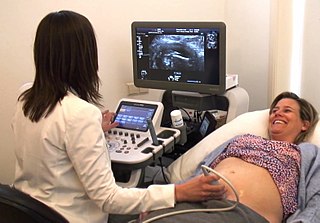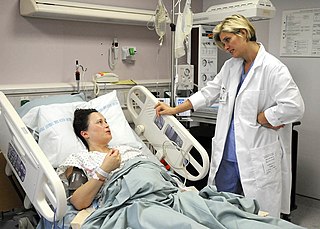Related Research Articles

Midwifery is the health science and health profession that deals with pregnancy, childbirth, and the postpartum period, in addition to the sexual and reproductive health of women throughout their lives. In many countries, midwifery is a medical profession. A professional in midwifery is known as a midwife.
A birthing center or centre is a healthcare facility, staffed by nurse midwives, midwives and/or obstetricians, for mothers in labor, who may be assisted by doulas and coaches. By attending the laboring mother, the doulas can assist the midwives and make the birth easier. The midwives monitor the labor, and well-being of the mother and fetus during birth. Should additional medical assistance be required the mother can be transferred to a hospital. Some hospitals are now adding birth centers to their facilities as an alternative to the high tech maternity wards commonly found at most hospitals.
A home birth is a birth that takes place in a residence rather than in a hospital or a birthing center. They may be attended by a midwife, doula, or lay attendant with experience in managing home births. Home birth was, until the advent of modern medicine, the de facto method of delivery. The term was coined in the middle of the 19th century as births began to take place in hospitals. Since the beginning of the 20th century, home birth rates have fallen in most developed countries, generally to less than 1% of all births. Infant and mother mortality rates have also dropped drastically over the same time period.
Barbara Vernon is an Australian maternity activist and a government lobbyist who seeks to improve provisions for maternity services; in particular, she advocates for the use of midwives. Born in New South Wales, she moved to Canberra in the mid-1970s. She earned an Honours Degree in Political Science at the Australian National University and in 1997 was awarded a PhD in public policy from Griffith University in Brisbane, Queensland.

In the United States, a Certified Nurse-Midwife (CNM) is a nurse midwife who exceeds the International Confederation of Midwives essential competencies for a midwife and is also an advanced practice registered nurse, having completed registered nursing and midwifery education leading to practice as a nurse midwife and credentialing as a Certified Nurse-Midwife. CNMs provide care of women across their lifespan, including pregnancy and the postpartum period, and well woman care and birth control. Certified Nurse-Midwives are exceptionally recognized by the International Confederation of Midwives as a type of midwife in the U.S..
A traditional birth attendant (TBA), also known as a traditional midwife, community midwife or lay midwife, is a pregnancy and childbirth care provider. Traditional birth attendants provide the majority of primary maternity care in many developing countries, and may function within specific communities in developed countries.
The Frontier Nursing Service provides healthcare services to rural, underserved populations and educates nurse-midwives.
Frontier Nursing University is a private non-profit graduate school in Hyden, Kentucky. The Leslie County school was established by the Frontier Nursing Service in 1939 as the Frontier School of Midwifery and Family Nursing.
A birth attendant, also known as skilled birth attendant, is a health professional who provides basic and emergency care to women and their newborns during pregnancy, childbirth and the postpartum period. A birth attendant, who may be a midwife, physician, obstetrician, or nurse, is trained to be present at ("attend") childbirth, whether the delivery takes place in a health care institution or at home, to recognize and respond appropriately to medical complications, and to implement interventions to help prevent them in the first place, including through prenatal care. Different birth attendants are able to provide different levels of care.
Sally Tracy DMid is an Australian, midwife, midwifery researcher, author and activist.
Ruth Watson Lubic, CNM, EdD, FAAN, FACNM, is an American nurse-midwife and applied anthropologist who pioneered the role of nurse-midwives as primary care providers for women, particularly in maternity care. Lubic is considered to be one of the leaders of the nurse-midwifery movement in the United States.
Obstetrical nursing, also called perinatal nursing, is a nursing specialty that works with patients who are attempting to become pregnant, are currently pregnant, or have recently delivered. Obstetrical nurses help provide prenatal care and testing, care of patients experiencing pregnancy complications, care during labor and delivery, and care of patients following delivery. Obstetrical nurses work closely with obstetricians, midwives, and nurse practitioners. They also provide supervision of patient care technicians and surgical technologists.

Addis Ababa Fistula Hospital and its regional Hamlin Fistula Centres provide comprehensive care for women who suffer from incontinence, physical impairment, shame and marginalisation as a result of an obstetric fistula. The hospital was created by the Australian obstetrician and gynaecologists Catherine Hamlin and her husband Reginald Hamlin to care for women with childbirth injuries and has been in operation since 1974. It is in Addis Ababa, the capital of Ethiopia. It is the only hospital of its kind in the world dedicated exclusively to women with obstetric fistula, and it treats all patients free of charge. Patients undergo surgical repair by Ethiopian and expatriate surgeons trained at the hospital's main facility in Addis Ababa. Around 93% of these patients are repaired successfully.
Obstetric medicine, similar to maternal medicine, is a sub-specialty of general internal medicine and obstetrics that specializes in process of prevention, diagnosing, and treating medical disorders in with pregnant women. It is closely related to the specialty of maternal-fetal medicine, although obstetric medicine does not directly care for the fetus. The practice of obstetric medicine, or previously known as "obstetric intervention," primarily consisted of the extraction of the baby during instances of duress, such as obstructed labor or if the baby was positioned in breech.
Midwives in the United States provide assistance to childbearing women during pregnancy, labor and birth, and the postpartum period. Some midwives also provide primary care for women including well woman exams, health promotion and disease prevention, family planning options, and care for common gynecological concerns. Before the turn of the 20th Century, traditional midwives were informally trained and helped deliver almost all births. Today, midwives are professionals who must undergo formal training. Midwives in the United States formed the Midwifery Education, Regulation, and Association task force to establish a framework for midwifery.
One To One Midwives was an independent midwifery company founded by Joanne Parkington, a midwife in Birkenhead. The company was officially named One to One Ltd. On 29 July 2019, Joanne Parkington informed her staff the company would cease trading on 31 July 2019.

A midwife is a health professional who cares for mothers and newborns around childbirth, a specialization known as midwifery.

A nurse midwife is both a nurse and a midwife, having completed nursing and midwifery education leading to practice as a nurse midwife and sometimes credentialed in the specialty. Nurse midwives provide care of women across the lifespan, including during pregnancy and the postpartum period, and well woman care and birth control.
Midwives in South Africa are nurses who focus on the care of pregnant women and the delivery of babies. Midwives have the ability to work independently in cases of healthy pregnancies and problem-free deliveries; however, they can refer patients to gynaecologists or obstetricians when complications are diagnosed. The majority of pregnant women in South Africa use the public healthcare system, and most of this care is provided by midwives.

The American College of Nurse-Midwives (ACNM) is a professional association in the United States, formed in 1955, that represents certified nurse-midwives (CNMs) and certified midwives (CMs). Dating back to 1929, ACNM is the leading example for excellence in midwifery education and practice in the United States and has a special interest in promoting global health in developing countries. "Our members are primary care providers for women throughout the lifespan, with a special emphasis on pregnancy, childbirth, and gynecologic and reproductive health. ACNM reviews research, administers and promotes continuing education programs, and works with organizations, state and federal agencies, and members of Congress to advance the well-being of women and infants through the practice of midwifery."